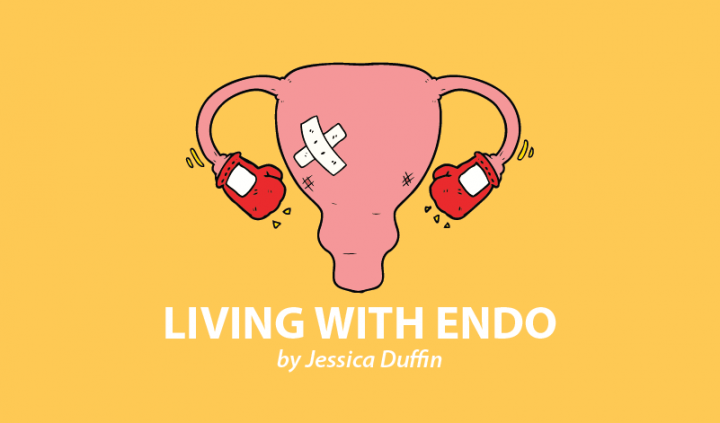I spend most of my days sharing tips and information about managing endometriosis. I talk about what has worked for me and what helps me to live almost entirely pain-free. In this column, I thought I’d tell you what I would do if I could go back in time, knowing what I know now.
Tracking symptoms
Before my diagnosis, I would have carried out more research into my symptoms. I would have kept a diary of my pain and other symptoms to take to appointments. Endometriosis UK offers this online resource, as well as advice about seeking a diagnosis. If I had been lucky enough to stumble across that information, I would have used it.
Anti-inflammatory diet
Many of us know how long we may have to wait for surgery, especially in the U.K.’s National Health Service. I waited for about a year for my first surgery and two years for my second. Many of us can’t endure pain for that long.
That’s why I would have adopted an anti-inflammatory diet before my diagnostic laparoscopy. This diet is recommended for people with chronic pain conditions such as arthritis. I would have at least cut out sugar and caffeine to give me a better quality of life while waiting for surgery – though I saw the most benefits when I eliminated dairy and gluten, too.
I would have also begun taking an omega-3 supplement (I’m vegan, so I wouldn’t have upped my level of oily fish, but you could), along with evening primrose oil and turmeric. Omega-3 has been shown to help alleviate pain, evening primrose blocks inflammatory compounds, and turmeric is believed to have anti-inflammatory properties. I’ve found all of these, especially the turmeric, incredibly helpful in reducing my endometriosis pain.
Specialists
Once endometriosis had been mentioned, I would have sought out a specialist. The number of specialists adequately trained to treat endometriosis in the U.K. and the U.S. is appallingly small. Unfortunately, neither of the specialists I’ve consulted have been up to scratch. You can find a skilled specialist by searching for Accredited Endometriosis Centers on the British Society of Gynaecological Endoscopy’s website or by asking for recommendations from Nancy’s Nook Facebook group.
Excision surgery
Endometriosis UK states that excision (think of removing a verruca from the root) is the best surgical treatment for endometriosis. However, many surgeons, especially those who aren’t endometriosis specialists, perform ablation surgery. The trouble with this method is that it often leaves cells behind, causing continued pain and regrowth, not to mention scar tissue.
My first surgery was ablation, and my second, despite believing I was going to have excision, was ablation. The positive effects of the first surgery wore off in two years; the second surgery made no difference at all.
If I have another surgery, I will insist on excision, and if the specialist cannot guarantee that method, I’ll find someone who will.
Surgery prep
I would have also made sure my body was adequately prepared and supported before surgery to enable better healing. My groundwork would have included following an anti-inflammatory diet for at least a month before the surgery, taking omega-3 supplements to reduce inflammation, and upping my antioxidant levels to support healing. I thoroughly recommend reading “Take Control of Your Endometriosis” if you’re interested in learning more.
Pelvic floor therapy
Thanks to my conversations with experts like Jessica Drummond and Heba Shaheed, I’ve learned about the importance of pelvic floor health when managing our pain levels. Many of us with endometriosis have tight pelvic floors due to pain. This tension puts pressure on our nerves, causing more pain and creating a vicious cycle.
Surgery often heightens this tension. Pelvic floor therapy can reduce muscle tension and set you on the right healing path following surgery. (Check with a practitioner about when to commence with therapy post-surgery.)
Hormone regulation
Once I had regained my strength post-surgery, I would have implemented a hormone-supporting cleanse to reduce estrogen dominance in my body. I then would have adopted my current style of eating that balances my blood sugar and feeds my body with specific nutrients for each stage of my cycle. Balancing my hormones has helped me to alleviate my previous PMS symptoms, reduced my endo fatigue, and minimized my pain levels. I recommend checking out Flo Living for further information.
Cycle syncing
Finally, I would have adopted a lifestyle that works for, and with, my menstrual cycle. I recommend the following sources to learn more: “Period Power,” “Womancode,” and Red School.
***
Note: Endometriosis News is strictly a news and information website about the disease. It does not provide medical advice, diagnosis, or treatment. This content is not intended to be a substitute for professional medical advice, diagnosis, or treatment. Always seek the advice of your physician or other qualified health provider with any questions you may have regarding a medical condition. Never disregard professional medical advice or delay in seeking it because of something you have read on this website. The opinions expressed in this column are not those of Endometriosis News or its parent company, BioNews Services, and are intended to spark discussion about issues pertaining to endometriosis.

